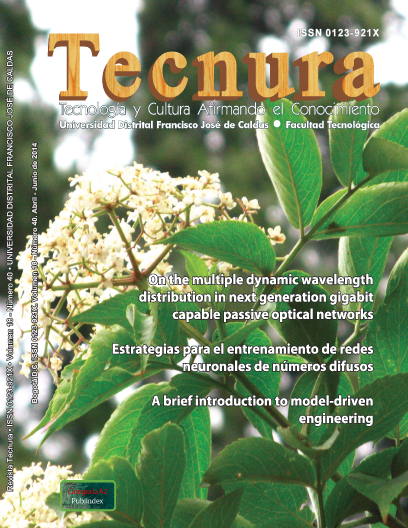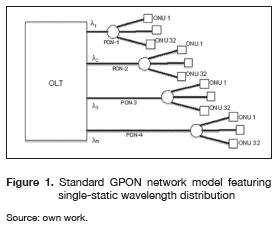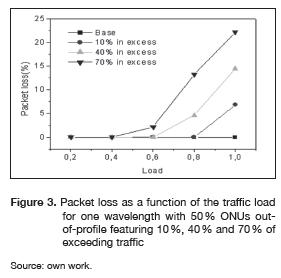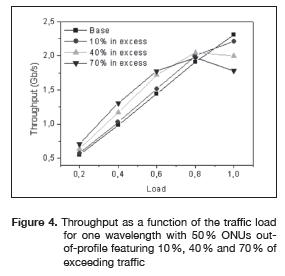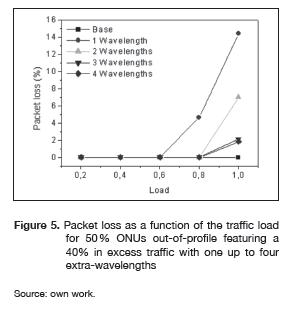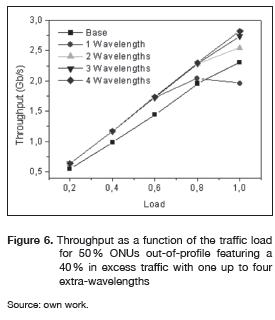DOI:
https://doi.org/10.14483/udistrital.jour.tecnura.2014.2.a01Publicado:
01-04-2014Número:
Vol. 18 Núm. 40 (2014): Abril - JunioSección:
InvestigaciónUn estudio sobre distribución dinámica de longitudes de onda para redes gigabit ópticas pasivas
A study on the multiple dynamic wavelength distribution for gigabit capable passive optical networks
Descargas
Cómo citar
APA
ACM
ACS
ABNT
Chicago
Harvard
IEEE
MLA
Turabian
Vancouver
Descargar cita
A study on the multiple dynamic wavelength distribution for gigabit capable passive optical networks
Un estudio sobre distribución dinámica de longitudes de onda para redes gigabit ópticas pasivas
Gustavo Adolfo Puerto Leguizamon1, Jaime Andrés Vallejo Avellaneda2, Jhon Jaime Ramírez Ochoa3
1Ingeniero de Telecomunicaciones, Doctor en Telecomunicaciones. Docente de la Universidad Distrital Francisco José de Caldas. Bogotá, Colombia. Contacto: gapuerto@udistrital.edu.co
2Estudiante de Ingeniería Electrónica de la Facultad de Ingeniería de la Universidad Distrital Francisco José de Caldas. Bogotá, Colombia. Contacto: javallejoa@correo.udistrital.edu.co
3Estudiante de Ingeniería Electrónica de la Facultad de Ingeniería de la Universidad Distrital Francisco José de Caldas. Bogotá, Colombia. Contacto: jjramirezo@correo.udistrital.edu.co
Fecha de recepción: 1 de abril de 2013 Fecha de aceptación: 27 de noviembre de 2013
Clasificación del artículo: investigación
Financiamiento: Universidad Distrital Francisco José de Caldas
Abstract
This paper presents a data traffic based study aiming at evaluating the impact of dynamic wavelength allocation on a Gigabit capable Passive Optical Network (GPON). In Passive Optical Networks (PON), an Optical Line Terminal (OLT) feeds different PONs in such a way that a given wavelength channel is evenly distributed between the Optical Network Units (ONU) at each PON. However, PONs do not specify any kind of dynamic behavior on the way the wavelengths are allocated in the network, a completely static distribution is implemented instead. In this paper we evaluate the network performance in terms of packet losses and throughput for a number of ONUs being out-of-profile while featuring a given percentage of traffic in excess for a fixed wavelength distribution and for multiple dynamic wavelength allocation. Results show that for a multichannel operation with four wavelengths, the network throughput increases up to a rough value of 19% while the packet losses drop from 22 % to 1.8 % as compared with a static wavelength distribution.
Key words: Dynamic Wavelength Allocation, Gigabit Pon, Optical Access Networks, Passive Optical Networks, Service Distribution.
Resumen
Este artículo presenta un estudio con el propósito de evaluar el impacto de la asignación dinámica de longitudes de onda en una red de acceso Gigabit óptica pasiva (GPON). En redes de acceso ópticas pasivas (PON), un terminal de línea óptico (OLT) alimenta diferentes PONs de tal forma que una longitud de onda se distribuye uniformemente entre las diferentes unidades de red óptica (ONU) en cada PON. Sin embargo, las redes PON no definen ningún tipo de comportamiento dinámico en la asignación de longitudes de onda en la red, a cambio, implementa una distribución de tipo completamente estático. En este artículo se evalúan las prestaciones de una red óptica de acceso en términos del caudal efectivo y tasa de paquetes perdidos en diferentes escenarios que describen un número dado de ONUs, presentando un comportamiento fuera de perfil con un porcentage dado de tráfico en exceso para una distribución fija de una longitud de onda y para una asignación dinámica de varias longitudes de onda. Los resultados muestran que, en una operación multicanal con cuatro longitudes de onda, el caudal efectivo se incrementa un 19% sobre el ancho de banda neto para la configuración con una longitud de onda mientras que el porcentaje de paquetes perdidos se reduce un 20,2 % cuando se compara con el escenario de distribución estática.
Palabras clave: asignación dinámica de longitudes de onda, Gigabit PON, distribución de servicios, redes de acceso ópticas, redes ópticas pasivas.
Introduction
GPON is becoming a popular choice for broadband access. In the downstream, GPON relies on concurrent TDM connections between the OLT and ONUs to distribute a bandwidth of up to 2.5 Gb/s among up to 128 subscribers (Angelopoulos, 2004). However, the tremendous growth of Internet traffic and video based applications will put into evidence the shortage of the access network capacity, with expected future services based on highly-bandwidth-consuming video applications as shown in a recent Cisco forecast traffic (Cisco, 2012). Based on that forecast, we have configured three potential customer profiles for both residential and corporative segments respectively. Table 1 shows the aggregated bandwidth for both segments after setting up services for each one of them. Clearly, video based services will dominate the bandwidth consumption with up to 150 Mb/s for future immersive videoconference services. In this context, an upgrade of the current static distribution scheme of actual GPON networks towards a more flexible and dynamic behavior is expected to cope with the ever increasing bandwidth demand, achieve higher capacities while maintaining the low cost of TDM-based devices and passive infrastructures (Davey, 2006), (Kazovsky, 2007). Unlike current GPON, in which each ONU receives one data wavelength from the OLT as seen in figure 1, the upgrade we propose include the broadcast of several wavelengths to link the Central Office (CO) to different ONUs as shown in figure 2. Each wavelength is shared among several ONUs rather than being dedicated to a single ONU and the wavelength assignment can be static or dynamically changed during the communication depending on whether a tunable or fixed filter is used for wavelength selection at the ONU (Hsueh, 2005).
When dynamic allocation is implemented, the ONUs can be either fed with one wavelength or receive a stack of wavelengths depending on the traffic load requested by the ONUs. Moreover, dynamic wavelength allocation adds some attractive features to PON such as power saving, as some of the wavelength feeders at the CO may be switched-off when the traffic load is low. In addition it enables load balancing by allowing each ONU to communicate with the CO using the less congested wavelength (Kani, 2010). It should be pointed out that upgrading the OLT to enable dynamic wavelength allocation imply the use of one fixed transmitter per additional wavelength at the CO. Tunable transmitters can also be used, however it results in a complex downstream distribution in terms of data control plane due to the TDM-like behavior of the optical bursts generated by the tunable transmitter. This paper presents the impact of implementing dynamic wavelength allocation in the framework of a GPON access network. For the sake of presenting relevant results, the evaluated model consists of an OLT which is feeding four different PON and each PON provides connectivity to 32 users. The bandwidth offered per PON is 2,5 Gb/s.
Method
The simulations based network evaluation was performed using the Network Simulator 2 (NS2) following the network model represented in figure 2. A segmentation of four PONs being fed by the same wavelength from the OLT was implemented. The capacity per PON, in accordance with the GPON standard, is 2,5 Gbps and each PON may consist of up to 128 nodes, in our context we used 32 nodes which represent the ONUs requesting data traffic from the OLT. For a steady state, i.e., when the capacity of a wavelength channel is distributed among the ONUs, each one of them receives a net bandwidth of roughly 79 Mb/s. However, in a near-term-future this bandwidth may not suffice if we consider the forthcoming set of services, mainly video based, which are highly bandwidth consuming as discussed in table 1. For this reason, incrementing the number of wavelengths sent from the OLT makes sense. In our approach, the OLT is able to broadcast up to three additional wavelengths among the four PON, each wavelength carries 2,5 Gb/s, therefore the additional bandwidth per PON is 622 Mb/s which leads to an added extra capacity at the ONU of approximately 19 Mb/s for each extra wavelength in the system. That is, the contribution of bandwidth per extra-wavelength channel is 19 Mb/s at each ONU. By doing so, upgrading the GPON capacity to support high bandwidth requirements becomes cost-effective, since no modification at the splitter is performed as seen in (Koonen, 2006), (Urban, 2009), (Koonen, 2011), which undoubtedly increases the overall network costs, but the added bandwidth is shared between the whole system due to the passive distribution behavior of a PON network while the dynamic bandwidth allocation relies on the use of tunable filters at each ONU to select the wavelength(s) channel(s) according to the bandwidth demand of the ONU. This approach enables a seamless upgrade from existing GPON deployments. The traffic pattern used in the simulations was exponential; this distribution depicts well the behavior of a real network traffic in the access segment. In NS2, it is represented as an ON-OFF traffic wherein the period in which packets are sent is equivalent to the average transmitted traffic. Finally the network is simulated as multiple unicast transmission, where each user receives a particular traffic within the boundaries of the allowed bandwidth per ONU. Relevant scenarios were proposed in order to evaluate the network performance in terms of packet losses and throughput. Each scenario represents the percentage of ONUs out-of-profile and how much traffic in excess is requesting for a particular number of available wavelengths. For this purpose, 50% out-of-profile ONUs were evaluated. An out-of-profile ONU means that the aggregated bandwidth (in excess) requested by the users belonging to that ONU is higher than the provided in the steady state, i.e., the base bandwidth of 79 Mb/s per ONU. For this percentage of ONUs out-of-profile, rates in excess of 10%, 40 % and 70% of the base bandwidth was evaluated. The scenarios were simulated for a traffic load of 0,2, 0,4, 0,6, 0,8 and 1, implementing the four wavelengths above mentioned. The traffic load is defined as the ratio between the number of bits transmitted per time unit and the link data rate.
Results
The results derived from the conducted simulations are shown in figures 3, 4, 5 and 6. In particular, figure 3 shows the percentage of packet loss as a function of the load for one wavelength carrying a 10 %, 40 % and 70 % of exceeding traffic when 50 % of ONUs were out-of-profile. The curve for the base condition, i.e., when all the ONUs were in-profile and no exceeding traffic was requested is also depicted for reference. As seen, the base curve does not present any variations on the packet loss as the load value increases. However, as the traffic in excess increases up to a maximum value of 70 %, the packet loss becomes significant for high traffic loads (>0,7) reaching approximately 22 % of lost packets. Note that roughly the same value of packet loss (13,5 %) is obtained for 70 % of exceeding traffic at a load of 0,8 and 40 % of traffic in excess at a load of 1. For low traffic loads (<0,4) with the evaluated conditions, the combined contribution of ONUs out-of-profile featuring several values of exceeding traffic does not impose any degradation on the packet loss in the network. Figure 4 shows the throughput, also as a function of the traffic load, for the scenario previously described. Note that the throughput is almost linear for medium-low traffic loads (<0,7) whereas for high load values the throughput becomes reduced steadily, mainly for exceeding traffic values higher than 40 %. For a 70 % exceeding traffic and a traffic load of 1, the throughput reaches a value of roughly 1,8 Gb/s which correspond to almost a 25 % less than the whole bandwidth of 2,5 Gb/s available in the system, as a result and following the trend from low to high exceeding rates, the network performance gets considerably jeopardized for exceeding traffic rates higher than 10 %.
To evaluate the benefit of having additional wavelength channels contributing to extra-bandwidth in the network, figure 5 shows the packet loss as a function of the traffic load for the base scenario, i.e. all the ONUs are in-profile, the figure also shows the results for a multichannel operation featuring 50 % of ONUs out-of-profile and a exceeding traffic of 40 % above the steady state. Recall that each extra-wavelength contributes to an added bandwidth of 625 Mb/s per PON which correspond to roughly 19,5 Mb/s per ONU. As seen, for a traffic load of 1 when just one wavelength is used in the network and there is a traffic excess of 40 %, the packet loss percentage is around 14%, however when an extra-wavelength with its associated bandwidth is used, the packet loss drops to 6,5 % and to nearly 1,8 % and 2 % when three and four extra-wavelengths respectively are added to the network. For medium and low traffic load values, the contribution of having extra wavelengths for 50 % of ONUs out-of-profile is nearly negligible.
Finally, the contribution of extra-wavelengths to the throughput for the previous scenario is shown in figure 6. The throughput in all wavelengths behaves linear for all the traffic loads except for the configuration with one wavelength, which at a high load (>0,8) due to the packet loss underwent as seen in figure 3, derives a reduction of the system throughput. For 2, 3 and 4 wavelengths, as the packet loss is reduced, the throughput is incremented reaching a net value of approximately 2,75 Gb/s for the case of three extra-wavelengths. It represents roughly a 19 % extra bandwidth in the network which is a measure of how much bandwidth in excess the network can provide in the event of high bandwidth requests.
Conclusions
A study on the on the multiple dynamic wavelength distribution for next generation GPON access networks was presented. The network model reuses the current fiber infrastructure deployed in the field, while proposes to upgrade both the Optical Line Terminal (OLT) and the Optical Network Unit (ONU) to support the future traffic demand in the access segment. The approach consists of using one wavelength as a base channel for a steady state of traffic demand in the network, i.e. all the PONs in the network are fed with the same wavelength when the data traffic demand is low. When the traffic requests exceed the available bandwidth in a given PON, a set of extra wavelengths are broadcasted evenly among all the PONs in the network, this approach enables a fast provision of bandwidth to ONUs as the network control and management can hardly predict which ONU or set of ONUs will request more bandwidth.
To this aim, the packet losses and the throughput for one wavelength feeding each PON with a bandwidth of 2,5 Gb/s and up to three extra wavelengths, which were broadcasted among four PONs were simulated. The contribution of an extra wavelength to each PON is of 625 Mb/s. Simulations consider relevant scenarios were different values of exceeding traffic (10 %, 40 % and 70 %) were evaluated for a base environment, i.e. all the ONUs are in-profile and for a 50 % of ONUs requesting exceeding traffic. Results show that when only one wavelength feeds the network (as normally occurs in GPON), the packet losses increase for high traffic loads featuring up to 22 % of lost packets when the exceeding traffic was 70 % above the base bandwidth per ONU (79 Mb/s). When extra wavelengths are implemented in the network, the packet loss percentage drops from 14% to 6,5 %, 2 and 1,8 % for one, two and three extra wavelengths respectively for the scenario with 50 % ONUs out-of-profile featuring 40 % of traffic in excess. As far as the throughput is concerned, a linear behavior for medium-low traffic load was observed, for high loads the throughput is reduced a 25 % of the total bandwidth in the network. For the multichannel operation, with four extra wavelengths, the throughput get incremented roughly 19 % above the net bandwidth for the one wavelength scenario.
Acknowledgement
The authors would like to acknowledge the Universidad Distrital Francisco José de Caldas for supporting the realization of this paper.
References
Angelopoulos J., Leligou H., Argyriou T., Zontos S., Ringoot E. & Van Caenegem T. (2004). Efficient transport of packets with QoS in an FSAN-aligned GPON. IEEE Comm. Mag., 42 (2) 92-98.
Cisco. (s. f.). Cisco Visual Networking Index: Forecast and Methodology 2012-2017. [Online]. Available http://www.cisco.com/en/US/solutions/collateral/ns341/ns525/ns537/ns705/ns827/white_paper_c11-481360.pdf
Davey R., Kani J., Bourgart F. & McCammon K. (2006). Options for Future Optical Access Networks. IEEE Comm. Mag, 44 (10) 50-56.
Hsueh Y., Rogge M., Yamamoto S. & Kazovsky L. (2005). A highly flexible and efficient passive optical network employing dynamic wavelength allocation. IEEE J. of Lightwave Technol., 23 (1), 277-286.
Kani J. (2010). Enabling Technologies for Future Scalable and Flexible WDM-PON and WDM/TDM-PON Systems. IEEE J. of Selected Topics in Quantum Electron., 16 (5),1290-1297.
Kazovsky L., Shaw W., Gutierrez D., Cheng N. & Wong S. (2007). Next-Generation Optical Access Networks. IEEE J. of Lightwave Tech, 25 (11), 3428-3442.
Koonen, T. (2006). Fiber to the home/fiber to the premises: What, where and when? Proc. of the IEEE, 94 (5), 911-934.
Koonen, T., Tran N. & Tangdiongga, E. (2011). The merits of reconfigurability in WDM-TDM optical in-building networks. Optical Fiber Communication Conference and Exposition (OFC/NFOEC), 2011 and the National Fiber Optic Engineers Conference.
Urban P., Huijskens F., Khoe G., Koonen T. & De Waardt H. (2009). Reconfigurable WDM/TDM Access Network Providing 10-Gb/s/Over 27-km SSMF With Colorless ONU. IEEE Photon. Technol.Lett., 21 (23) 1758-1760.
Licencia
Esta licencia permite a otros remezclar, adaptar y desarrollar su trabajo incluso con fines comerciales, siempre que le den crédito y concedan licencias para sus nuevas creaciones bajo los mismos términos. Esta licencia a menudo se compara con las licencias de software libre y de código abierto “copyleft”. Todos los trabajos nuevos basados en el tuyo tendrán la misma licencia, por lo que cualquier derivado también permitirá el uso comercial. Esta es la licencia utilizada por Wikipedia y se recomienda para materiales que se beneficiarían al incorporar contenido de Wikipedia y proyectos con licencias similares.

